Can America’s moviegoing habit be saved? The past, present and uncertain future of the multiplex
- Share via
The Golden Age of the multiplex is in the past. Or is it? Theater owners are luring a new generation with upgraded screens, seats and snacks. Even with rising prices — not to mention tech distractions and rude patrons — we still fall for that old cinema magic. Join us as our reporters and critics explore the past, present and future of moviegoing.
Rumbling seats. Virtual reality. Booze. Theaters plot the future of cinema in uncertain times
Like many people, one of my first jobs growing up was in a movie theater. I spent summer 2005 sweeping up popcorn and sneaking into midday screenings of “Wedding Crashers” at an UltraStar Cinemas in San Diego. At the time, cup holders were considered fairly innovative and stadium seating was the height of luxury. Everyone still bought paper tickets at the box office, and the food menu was limited to popcorn, bad hot dogs and Junior Mints.
Today, moviegoers pay for tickets online and get their phones scanned at the door. They eat restaurant-style food and sip movie-themed cocktails in theater lounges before the films. They can even order food and wine while relaxing in their leather recliner seats.
Moviegoers have increasingly innovative and expensive options, especially in Los Angeles, a laboratory of multiplex innovation. The cinema industry is trying everything it can — motion seats, virtual reality and even competitive video gaming — to see what takes hold.
READ MORE on multiplex innovations »
The architecture of moviegoing: Can the multiplex stay in the picture?
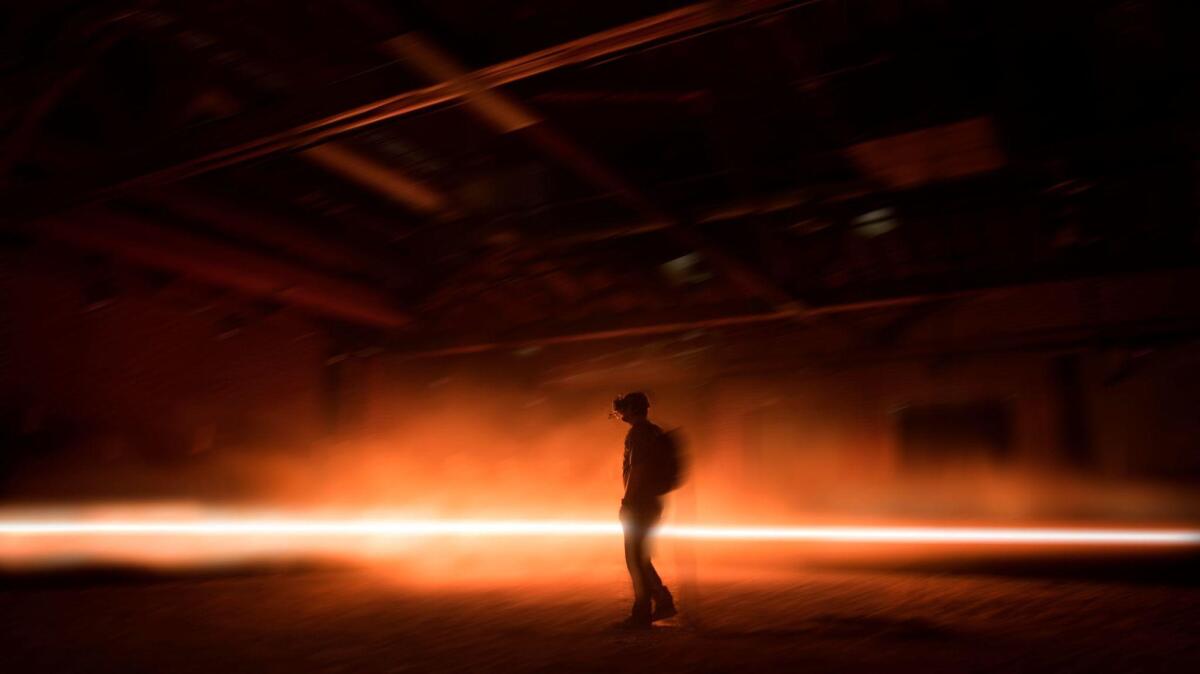
I read a lot of magazines, blogs and social-media feeds dedicated to architecture — more than I’d like to admit. None of them covered the news that Alejandro Iñárritu’s contribution to the Cannes Film Festival this year came in the form of a 6-minute experiment in virtual-reality filmmaking.
They probably should have.
“Carne y Arena,” a collaboration between Iñárritu and his longtime cinematographer, Emmanuel Lubezki, was described by my colleague Steven Zeitchik as “a multi-platform experience that includes a VR film; it is so sprawling the festival installed it in an airplane hangar 20 minutes outside downtown Cannes.” Viewers strapped on Oculus Rift headsets and then set out on foot to experience a 360-degree story set in the Arizona desert, along the U.S.-Mexico border.
What does this have to do with architecture? Everything.
READ MORE from Hawthorne’s essay »
‘It's “Cheers” for movie lovers’: Quentin Tarantino's New Beverly Cinema
Magic hour in Los Angeles can be intoxicating in the dreamy haze of dusk, skies aglow in pinks and purples like a gauzy scene straight out of the pictures. At the New Beverly Cinema, the last pure bastion for 35-mm film in La La Land, the sun fades into extra romance every night for movie lovers waiting outside the box office under its iconic red-lettered marquee.
On a recent Friday magic hour, standing patiently in line for a standby ticket to a sold-out double feature of “Pee-wee’s Big Adventure” (1985) and “Ed Wood” (1994), is cinephile Cody Chavez, 27, who sports a homemade Pee-wee Herman costume and a giant grin on his face.
“I’ve been a huge fan of Pee-wee’s ever since I saw his show as a kid,” says Chavez, who came from Orange County to catch the Tim Burton twofer at the Quentin Tarantino-owned New Beverly, where double features of classic, indie, cult and foreign flicks screen each night and every feature, trailer and vintage cartoon is projected the old-fashioned way — on film, glorious 35-mm film.
READ MORE from Yamato on the New Beverly »
Going to the movies isn't just about the movies; it's how we grow up
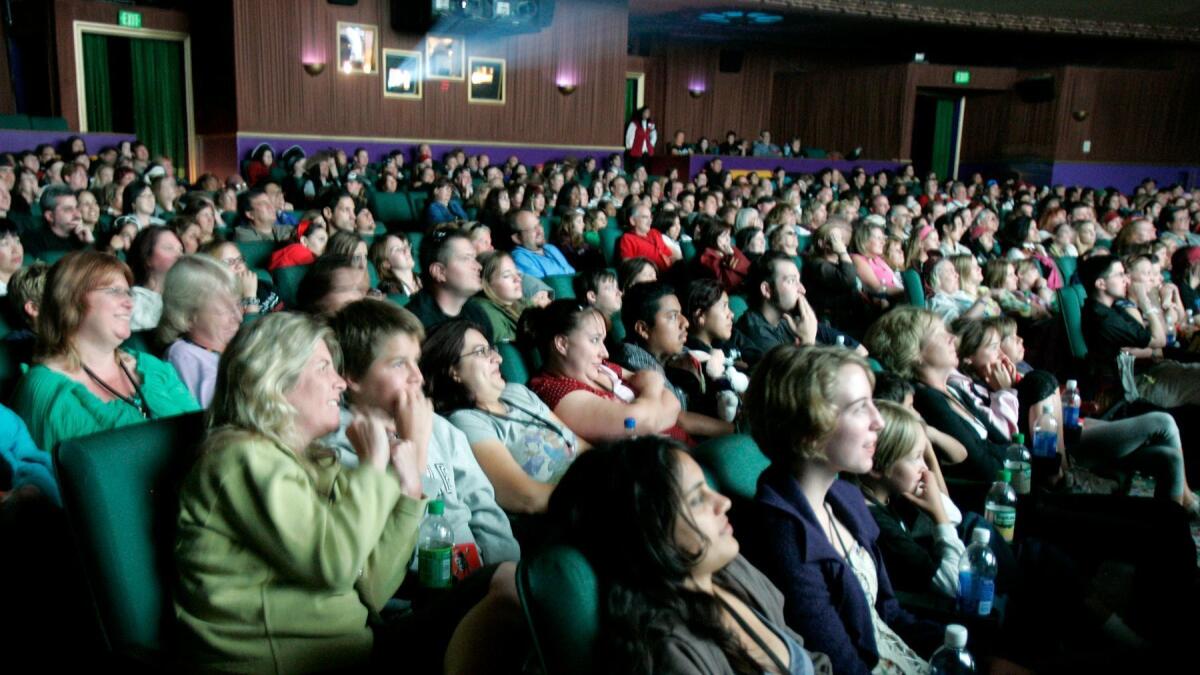
Television, videotape, Blockbuster, home theaters, on-demand, Netflix — the cineplex has been under siege from modern upstarts for decades. But it’s impossible to imagine a world without the big screen if only because going to the movies has always been as much about the ritual of “going to” as it is about “the movies.”
“Going to the movies.” It’s a universal phrase that is somehow distinctly American, shorthand for all manner of personal and social significance.
“Going to the movies” is a Proustian madeleine, a series of pencil marks on a doorjamb, a solution to crises ranging from heartbreak to parental exhaustion, a way of being separate but together, present yet adrift.
It’s also something people don’t do as often as they once did. The new technology and quality of television especially has turned viewers into homebodies, never far from their laptops and flat screens.
READ MORE from McNamara's essay »
What are your earliest memories of going to the movies? Here are some of ours
When moviegoers treat theaters like living rooms — texting, talking, even diaper changing happens
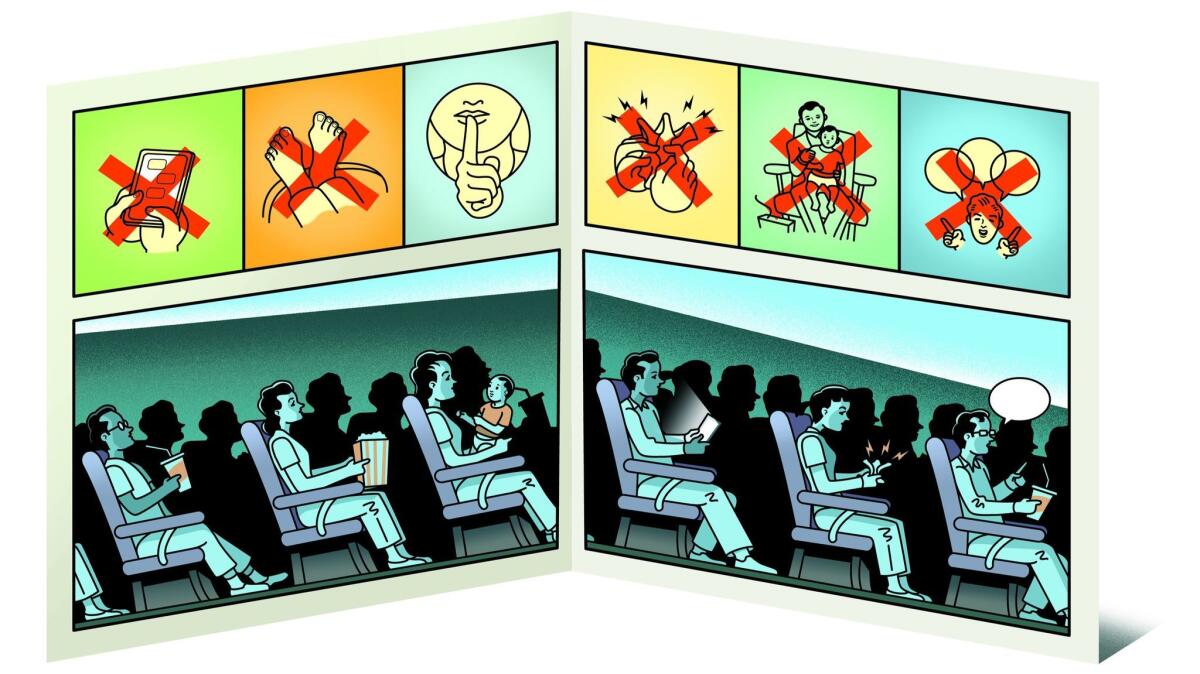
Not long ago, I went to see “Get Out” at my local Long Beach multiplex. Based on the buzz and reviews for Jordan Peele’s unsettling horror film, my anticipation was driving me insane. I could not wait to see this movie!
And that, partly, was my problem. I should have waited — at least a few more hours past the matinee. See, shortly after settling in, a woman arrived carrying a toddler and took a seat a couple of rows in front of me. The little one immediately began to deliver a running stream of commentary about the ads on the screen. I discretely switched seats, creating a buffer zone that I hoped would shield me.
But it was a cozy theater, so, even with some separation, I was getting an earful of jabbering throughout the film. I’m not a psychologist so I won’t speculate on how watching “Get Out” might have affected this child. (When I was a kid, the tomfoolery in “The Apple Dumpling Gang” kept me awake at night. But I digress.)
READ MORE from Whipp on moviegoing etiquette »
Why I'm shushhhing you: Using your phone in a movie theater isn't a private act, but a public insult

Shane Danielsen, a filmmaker who has worked as a film journalist, critic and artistic director of Scotland’s Edinburgh International Film Festival, has spent a significant portion of his life in movie theaters. His mother has long predicted that he will meet his death in one of these theaters.
That’s because in the 12 years I’ve known Danielsen, he has been a vigorous and conscientious shusher. For him, the experience of seeing a movie in a darkened theater or screening room is predicated on an unspoken but binding social contract. And when you light up your phone mid-movie to check Facebook or send a text message, distracting yourself and those around you from the immersive and dreamlike power of the cinema screen, you are in violation of that contract and should be reprimanded accordingly.
For Danielsen’s sake, I hope his mother’s dire prediction is wrong, though there’s certainly enough evidence out there to support her theory. Stories about physical violence erupting in theaters, often triggered by someone’s excessive talking or phone use, have become troublingly commonplace — and usually (though not always), the violent act is committed by the shushee, not the shusher. I’ve never forgotten the troubling story of a 2010 incident at a Lancaster theater, where a man asked a woman to turn off her phone and wound up getting stabbed in the neck with a meat thermometer by the woman’s boyfriend.
READ MORE from Chang on shushing »
Racing through Rome before the ticket booth goes dark and other faraway moviegoing adventures

I don’t remember the name of the theater. It was long ago in an alley not far from the Trevi Fountain in Rome. The bus had dropped us off in the rain and we hurried to the ticket booth, where a woman in a sweater, hair prim and gray, was sipping an aperitif and reading a newspaper in the lamplight.
“Due biglietti, signora.”
“No. Finito”
We had recently moved to our new city, and my daughter, Hannah, did not yet speak Italian. But she knew “finito” was not good. The theater was empty, the concession dark. “Spice World” had had its last showing. The new Spice Girls movie was supposed to have run through the week, but as we would discover with many things Italian, schedules were approximations subject to unpredictable whims.
“Finito.”
READ MORE on Fleishman’s faraway moviegoing »
After the buzz: Reflections of the last man to see 'Get Out' in a theater
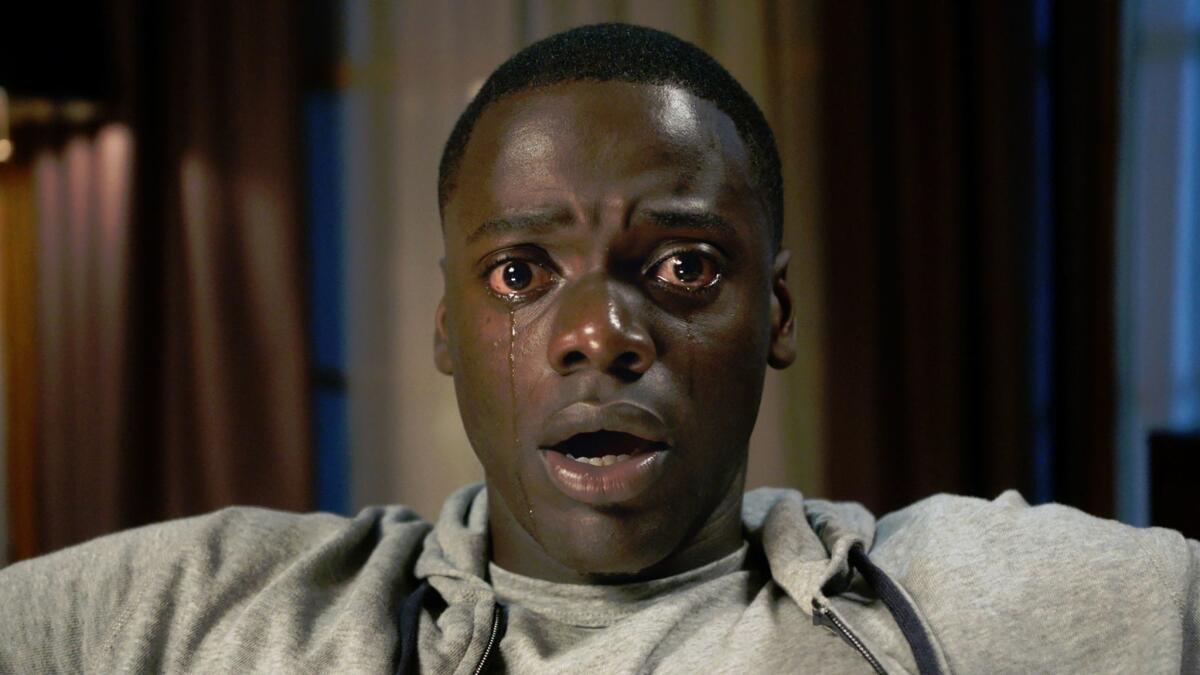
The last shall be first, the Bible famously notes. But it also insists the first shall be last, and that was exactly the situation I found myself in with the hugely popular “Get Out.”
Being in the first wave of viewers is practically part of the job definition for a critic. You see the film before it hits theaters so you can advise moviegoers if it’s worth their time. Be there or be very square indeed.
But sometimes, like a knuckleball thrown in the dirt, a film gets past you. Maybe you weren’t a fan of the genre, maybe you didn't believe friends who raved, maybe there simply wasn't enough time. Often it doesn't matter, but sometimes the film you missed becomes the talk of the nation.
READ MORE from Turan’s essay »
Teens at the multiplex: Why some of the young are returning to theaters
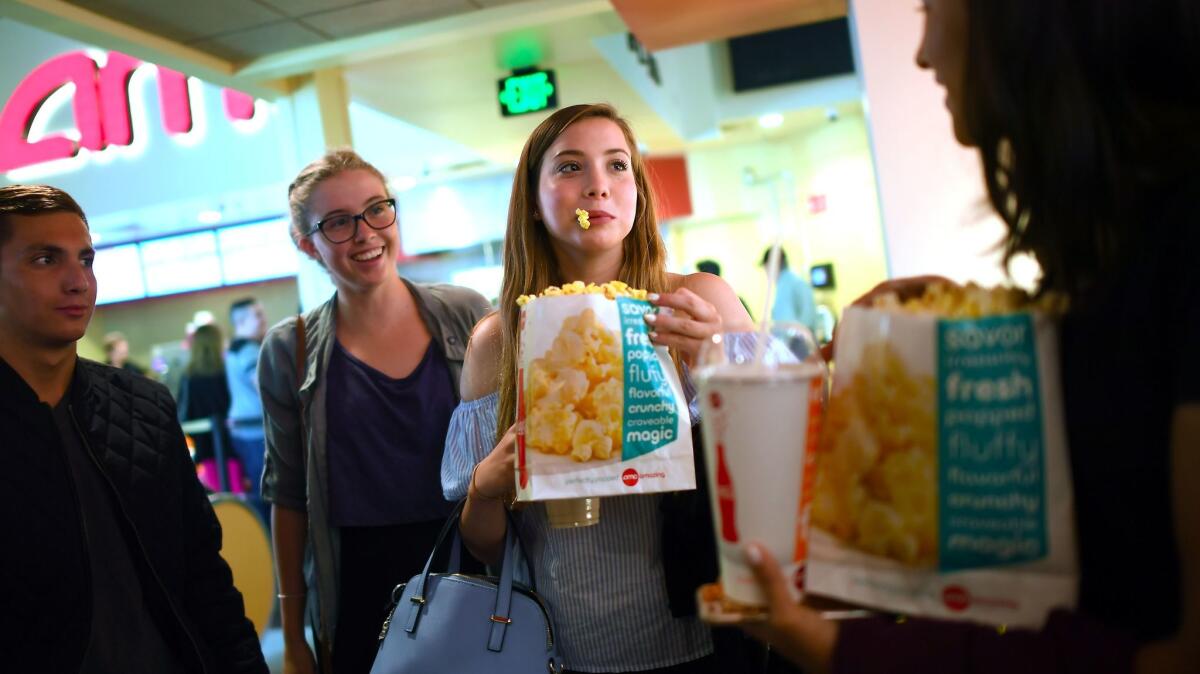
At this year’s CinemaCon, the annual gathering of movie theater owners held in Las Vegas each spring, Hollywood presented unexpected news. After years of shying away from the multiplex, young people in North America were returning to the cinema. The number of frequent moviegoers ages 18 to 24 jumped to 7.2 million — a 26% increase from 5.7 million in 2015. That’s still significantly lower than in 2012, when there were 8.7 million frequent moviegoers in the same age group, but there was also an uptick last year among frequent moviegoers 12 to 17 and 25 to 39. (The Motion Picture Assn. of America, which reported the statistic, defines “frequent moviegoers” as those who see one or more movies per month.)
In an era when Netflix is buying award-winning content at film festivals and theatrical windows are shrinking, it is somewhat of a surprise that the young are getting off the couch to head to the theater. To get a sense of what might be luring high schoolers and college students to the box office, we asked six teenagers — all on the cusp of turning 18 — if we could crash their movie date. They chose the movie (“Baywatch”) and the theater (AMC Santa Monica 7). We paid for the tickets ($13.29 per student).
READ MORE on teens at the movies »
An unexpected rise in young moviegoers
Frequent moviegoers in the U.S. and Canada increased by 2.1 million in 2016, according to the annual Theatrical Market Statistics report put out by the Motion Picture Assn. of America. After four straight years of declines in the number of frequent moviegoers age 12 to 17 and 18 to 24, both groups saw increases in 2016.
Frequent moviegoers (millions) by age
Ages 18 to 24
- 2012: 8.7 million
- 2013: 7.2 million
- 2014: 7.0 million
- 2015: 5.7 million
- 2016: 7.2 million
Average Cinema Ticket Price (U.S.$)
- 2007: $6.88
- 2008: $7.18
- 2009: $7.50
- 2010: $7.89
- 2011: $7.93
- 2012: $7.96
- 2013: $8.13
- 2014: $8.17
- 2015: $8.43
- 2016: $8.65
- Source: National Assn. of Theater Owners
Screen it from the rooftops: How outdoor movie screenings have become a 'selfie paradise' for millennials
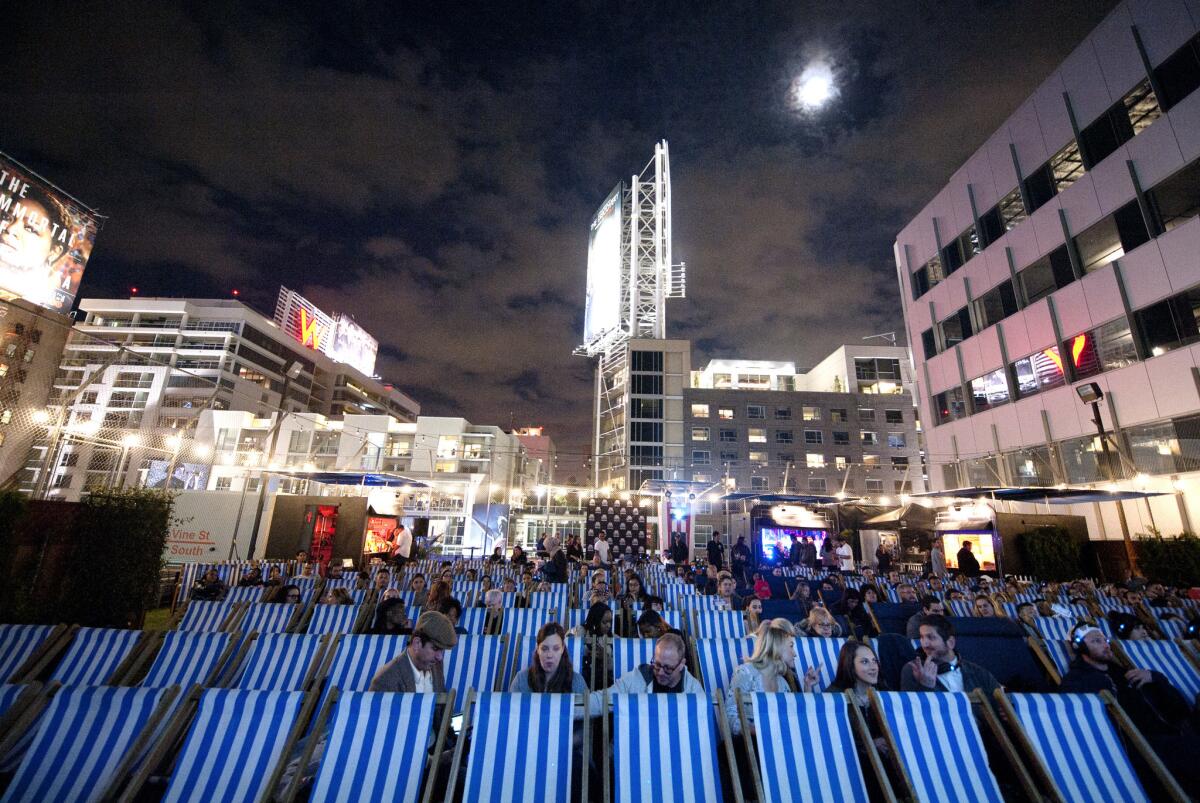
On the roof of Hollywood's Montalban Theater, under a nearly starless sky, guests huddled beneath fleece blankets just after sunset to watch (or re-watch) the 1990s mob drama "Goodfellas."
The screening, four flights up from Hollywood's bustling Vine Street, was arranged by the bicoastal and bicontinental Rooftop Cinema Club, with movies offered almost every summer evening through October.
The brainchild of Gerry Cottle Jr., the son of a circus owner who started RCC branches in London, New York and Los Angeles on "a wing and a prayer (and a loan from the bank)," the club provides guests with a blanket and a set of wireless headphones before screening cult, classic and newly released fan-favorite films like "Dirty Dancing," "Casablanca," "Moonlight," "La La Land," "Donnie Darko" and "Get Out."
"I saw this rooftop in London and I just thought, 'Well, people have [shown movies] in parks and I've seen some great screenings outdoors,” Cottle says. “But what a way to do it in the city surrounded by buildings."
READ MORE on outdoor cinemas »
A film festival every night: The new ecology of the old-movie scene in L.A.
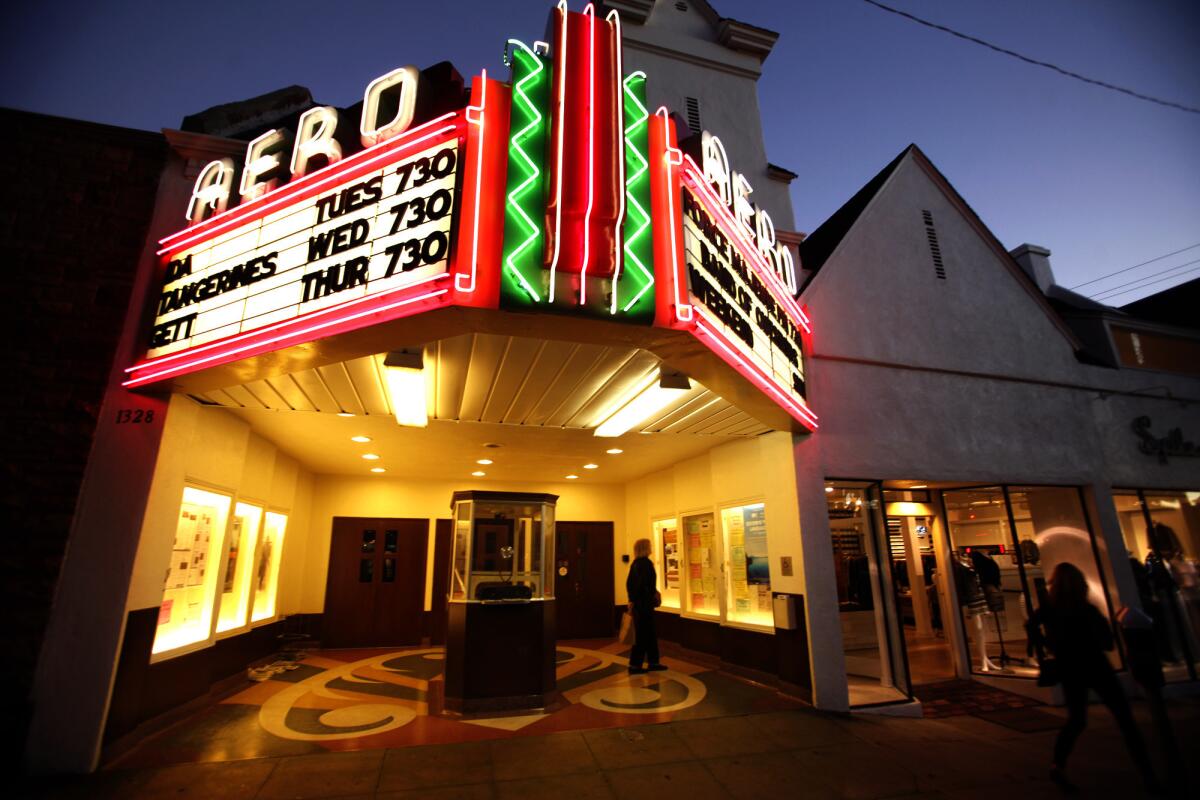
For a certain kind of dedicated moviegoer, Los Angeles can be a nonstop film festival. Just about any day of the week somewhere in the city there is a screening of a rare title, an exceptional film print or an event with special guests.
The scene around the city for showing older films, often referred to as repertory screenings, has been recently revitalized, flying in the face of conventional wisdom regarding moviegoing overall and the era of downloading and streaming. Going to a movie theater can still be an experience like no other.
At venues around the city such as the Motion Picture Academy’s Samuel Goldwyn and Linwood Dunn theaters, the
READ MORE on the new golden age of rep cinema »
Step into the past with Last Remaining Seats
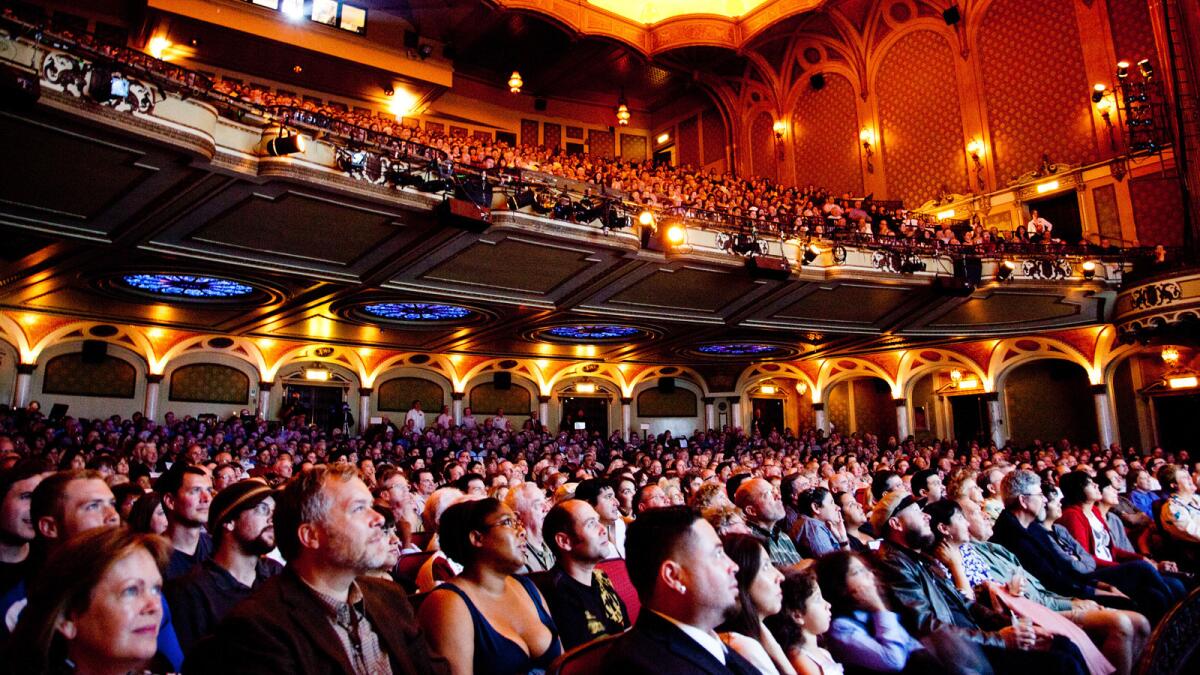
The movie theaters of my youth were hardly palaces. They were largely generic multiplexes with the twins and triplexes giving way in the 1970s and ’80s to behemoths housing a dozen or more screens in auditoriums barely the size of your living room. Apart from the odd curio — the Cinedome in Orange, anyone? — it was strictly the movies that made the moviegoing experience memorable.
For earlier generations, it was very different. The tiny storefront nickelodeons that proliferated in big cities and small towns across the country gradually took over legit theaters and vaudeville houses. And then shortly after World War I, exhibitors began luring audiences with increasingly luxurious theaters that were definitely palatial. Even seeing the routine studio programmers became an event. In Los Angeles, these venues lined Broadway, their fortunes rising and falling over the decades with that of the downtown core. Most experienced a cycle that included periods of live performances, second-run status, an embrace of the Spanish-speaking culture, hosting churches and the recent gentrification of the area.
In 1987, the Los Angeles Conservancy launched its Last Remaining Seats series, giving contemporary moviegoers the chance to see classic films in spaces like the ones their parents, grandparents and great-grandparents once visited. This year’s lineup includes five Broadway theaters plus, for the first time, a foray to the South Bay with San Pedro’s Warner Grand.
Only good movies
Get the Indie Focus newsletter, Mark Olsen's weekly guide to the world of cinema.
You may occasionally receive promotional content from the Los Angeles Times.








